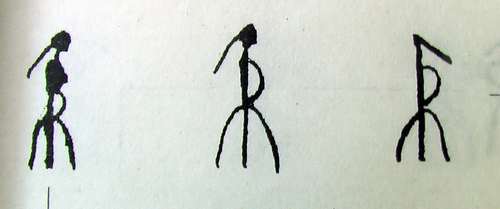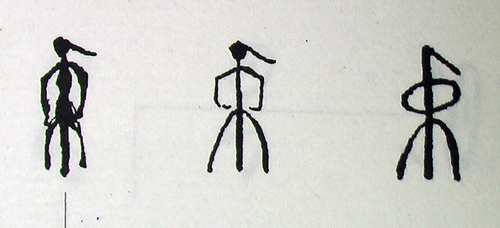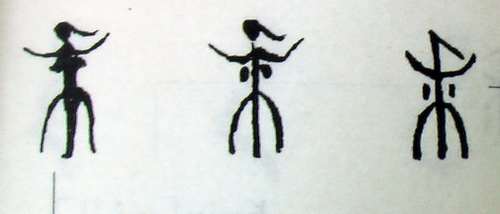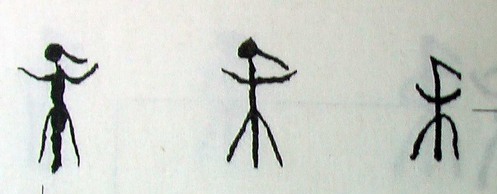The Yi script has a history as complex as their own history. Perhaps is the inherent difficulty with which we meet when we want to define concepts strange to our culture, according to our own way of perceiving them. There are some legends that say that the Yi script was invented toward 7th or 8th the century, although there is not certainty of its use until the documents carved in stone of the 14th century. Nevertheless the specialists have the suspicion that some of the books used by their pimos or traditional priests can be older than the well-known inscriptions.
On the other hand, their writing shows certain resemblance with the symbols used by the Neolithic residents of Bampo village, a population that lived more than 5.000 years ago in the outskirts of the current city of Xian, although the essays dedicated to this matter have not reached a conclusion.
The Yi script supposes a big challenge for the science and the traditional linguistics, because on one side it doesn't keep relationship with none of the writings of its neighboring peoples, and besides, given its religious and ritual use, limited to a type of priests, exist numerous local variations, and at least four different Yi scripts have been recognized with important differences.
The Yi scripts are syllabic writings. But as the Yi languages are fundamentally monosyllabic, it can be discovered in them vestiges of a possible evolution from more archaic pictograms.
In this way, the Yi scholar, Ayutieri, has dedicated great effort to investigate the relationship of the Nuoso characters (the branch of the Yi that has preserved their traditions better from their mountainous bastion of Liangshan) with the pictograms. (1) We reproduce here his interesting explanation on some of the characters related with the women.

We see that the old character for "mother" is formed from the evolution of a pictogram of a pregnant woman, with the long hair and a long skirt. In the simplified image (to the right) it still highlights her protuberant body and her long hair.

In the character for "skirt" and "trousers" we see that in its origin it consisted on a pictogram of a woman getting up the skirt. Now the hands are emphasized (the circle of the center) and the borders of the skirt that fall until the floor.

"Older sister" is represented like a woman with the long hair and the arms up. She dressed a skirt that hangs down until the floor, like it is habitual among the Nuoso. The two points in the center of her body represent her breasts.

The Yi script has a history as complex as their own history. Perhaps is the inherent difficulty with which we meet when we want to define concepts strange to our culture, according to our own way of perceiving them. There are some legends that say that the Yi script was invented toward 7th or 8th the century, although there is not certainty of its use until the documents carved in stone of the 14th century. Nevertheless the specialists have the suspicion that some of the books used by their pimos or traditional priests can be older than the well-known inscriptions.
On the other hand, their writing shows certain resemblance with the symbols used by the Neolithic residents of Bampo village, a population that lived more than 5.000 years ago in the outskirts of the current city of Xian, although the essays dedicated to this matter have not reached a conclusion.
The Yi script supposes a big challenge for the science and the traditional linguistics, because on one side it doesn't keep relationship with none of the writings of its neighboring peoples, and besides, given its religious and ritual use, limited to a type of priests, exist numerous local variations, and at least four different Yi scripts have been recognized with important differences.
The Yi scripts are syllabic writings. But as the Yi languages are fundamentally monosyllabic, it can be discovered in them vestiges of a possible evolution from more archaic pictograms.
In this way, the Yi scholar, Ayutieri, has dedicated great effort to investigate the relationship of the Nuoso characters (the branch of the Yi that has preserved their traditions better from their mountainous bastion of Liangshan) with the pictograms. (1) We reproduce here his interesting explanation on some of the characters related with the women.
We see that the old character for "mother" is formed from the evolution of a pictogram of a pregnant woman, with the long hair and a long skirt. In the simplified image (to the right) it still highlights her protuberant body and her long hair.
In the character for "skirt" and "trousers" we see that in its origin it consisted on a pictogram of a woman getting up the skirt. Now the hands are emphasized (the circle of the center) and the borders of the skirt that fall until the floor.
"Older sister" is represented like a woman with the long hair and the arms up. She dressed a skirt that hangs down until the floor, like it is habitual among the Nuoso. The two points in the center of her body represent her breasts.
"Younger sister" on the other hand, it shares with "older sister" all the attributes of the femininity. Except that her breast are not still shown evident.
On the other hand we see that in some occasions, the modifications of certain characters follow rules that we could call pictographic, as those derived of the eye. In those, we see that starting from a basic line used for eye, different organs and functions related with it, are defined adding up different affixes.
(1) Ayutieri.- Yi wen zixiang tangyuan. Sichuan Nationalities Press. Chengdu, 2001





